Galicien |
|
|
|
| Übersicht – Contents: | |
Diese Seite ist Teil des Projektes
Galicien |
|
|
|
| Übersicht – Contents: | |
Flagge – Flag: |
|
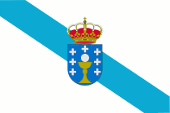 |
seit/since 1984, |
| historische und andere Flaggen – historical and other Flags: | |
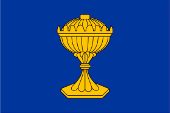 |
16. Jhd./16th cent., |
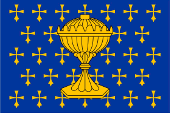 |
16. Jhd./16th cent., |
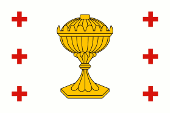 |
18. Jhd./18th cent., |
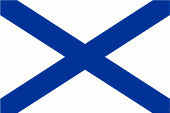 |
1845–1891, |
 |
seit/since 1891, |
 |
1977–1984, |
 |
Flagge linksgerichteter lokaler Nationalisten |
| Die heutige Flagge Galiciens wurde am 29.05.1984 eingeführt. Sie ist einfarbig weiß mit einem diagonalen, blauen Schrägrechtsbalken. Sie geht auf die historische See-Flagge der Stadt und Provinz La Coruña zurück. Diese zeigte ab 1845 ein blaues Diagonalkreuz auf weißem Grund, jedoch wurde sie im Jahre 1891 auf einen Schrägrechtsbalken reduziert um Verwechslungen mit der Russischen Marineflagge auszuschließen. Weiß und Blau gelten als die Farben der Jungfrau Maria. In der Mitte der Flagge das Wappen des Landes mit eine Königskrone darüber. Wappen aus der Frühzeit des Königreichs sind nicht bekannt, das Land kam 1071 an Kastilien-Leon, jedoch blieb das Land bis 1833 ein nominelles Königreich. Erste Wappen tauchten im 13. Jahrhundert auf. Sie zeigen auf blauem Grund einen oder mehrere goldene Kelche. Man geht davon aus, dass das Wappen nachträglich als "redend" interpretiert wurde, denn das spansische Wort "Cáliz" bedeutet Kelch, so das ein Kelch als Landessymbol von "Galicien" angenommen wurde. Ab dem 15. Jahrhundert wurde der Kelch als Hostienkelch (Ziborium) dargestellt, weil man das Gefäß im Wappen mit dem außergewöhnlichen Privileg der Kathedrale von Lugo in Verbindung brachte, die Hostie oder den Leib Christi öffentlich zur Schau zu stellen. Ab dem 16. Jahrhundert wurden goldene Kreuze um das Wappen gestreut. Ähnlich wird man die Wappenbanner bebildert haben, die Vorgänger der heutigen Flaggen. Verbindliche Flaggendarstellungen gibt es seit dem 18. Jahrhundert, hier ist die Flagge weiß, zeigt in der Mitte den Hostienkelch und links und rechts davon je drei rote Kreuze. Das ist erstaunlich, denn diese Farben weichen erheblich von denen der damals verwendeten Wappen ab. Unter der der Regierung des Generals Franco (1936–1975) waren alle regionalen Flaggen verboten. Nach Francos Tod (1975) wurden die regionalen Flaggen wieder eingeführt, auch in Galicien, wenn auch zunächst inoffiziell, da Galicien bis 1981 noch keinen Autonomiestatus hatte. Jedoch trug die Flagge bis 1984 kein Wappen. In den meisten autonomen Regionen Spaniens begann die neuere Flaggengeschichte bereits in den Jahren vor der Vergabe des Autonomiestatuts mit einer Flagge ohne Wappen, weil die Wappen oftmals noch gar nicht beschlossen waren. Immerhin hat sich meist durchgesetzt, dass die Flagge mit dem Wappen von den regionalen Behörden oder zu offiziellen Anlässen verwendet wird und die Flagge ohne Wappen quasi zu privaten, dekorativen Zwecken verwendet werden soll. Die Vorschrift "Die Farbtöne der Flagge von Galicien" vom 16.02.2022 regelt die Farben der Flagge und gibt folgende Pantone-Töne vor: Hellblau = pt 801, Mittelblau = pt 300, Rot = pt 186, Gold = pt 3975. Linke politische Gruppen, die für Galicien die Unabhängigkeit anstreben, verwenden die Flagge Galiciens ohne das Wappen, jedoch in der Mitte ergänzt um einen roten, fünfzackigen Stern. |
The current flag of
Galicia was introduced on 29th of May in 1984. It is plain white with a diagonal blue
diagonal bar. It goes back to the historical maritime flag of the city and
province of La Coruña. From 1845 onwards, it showed a blue diagonal cross on
a white background, but in 1891 it was reduced to a diagonal right bar to
avoid confusion with the Russian naval flag. White and blue are considered
the colours of the Virgin Mary. In the centre of the flag is the coat of
arms of the country with a royal crown above it. Coats of arms from the early days of the kingdom are not known, the country was annexed to Castile-Leon in 1071, but the country remained a nominal kingdom until 1833. The first coats of arms appeared in the 13th century. They show one or more golden chalices on a blue background. It is assumed that the coat of arms was subsequently interpreted as "speaking", because the Spanish word "Cáliz" means chalice, so a chalice was assumed to be the country's symbol of Galicia. From the 15th century onwards, the chalice was depicted as a host chalice (ciborium) because the vessel in the coat of arms was associated with the exceptional privilege of Lugo Cathedral to display the host or body of Christ in public. From the 16th century onwards, golden crosses were scattered around the coat of arms. The heraldic banners, the predecessors of today's flags, will have been depicted in a similar way. Reliable flag representations have existed since the 18th century; here the flag is white, shows the chalice in the middle and three red crosses to the left and right of it. This is surprising because these colors differ significantly from those of the coats of arms used at the time. Under the government of General Franco (1936-1975), all regional flags were banned. After Franco's death (1975), the regional flags were reintroduced, also in Galicia, albeit unofficially at first, since Galicia did not have autonomous status until 1981. However, the flag did not bear a coat of arms until 1984. In most autonomous regions of Spain, the more recent flag history already began in the years before the granting of the autonomy statute with a flag without a coat of arms, because the coats of arms had often not yet been decided. Nevertheless, it has mostly been accepted that the flag with the coat of arms is to be used by the regional authorities or on official occasions and the flag without the coat of arms is to be used quasi for private, decorative purposes. The regulation "The colours of the flag of Galicia" of 16th of February in 2022 regulates the colours of the flag and specifies the following Pantone shades: Light blue = pt 801, middle blue = pt 300, red = pt 186, gold = pt 3975. Left-wing political groups seeking independence for Galicia use the flag of Galicia without the coat of arms, but with the addition of a red, five-pointed star in the centre. |
| Quelle/Source: Wikipedia (ES), Wikipedia (GL), Flags of the World, Volker Preuß | |
Wappen – Coat of Arms: |
|
 |
seit/since 1984, Wappen von Galicien – coat of arms of Galicia, Quelle/Source, nach/by: Wikipedia (GL) |
historische Wappen – historical Coats of Arms: |
|
 |
13. Jahrhundert / 13th century, Wappen von Galicien – coat of arms of Galicia, Quelle/Source, nach/by: Wikipedia (ES) |
 |
15. Jahrhundert / 15th century, Wappen von Galicien – coat of arms of Galicia, Quelle/Source, nach/by: Wikipedia (ES) |
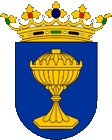 |
16. Jahrhundert / 16th century, Wappen von Galicien – coat of arms of Galicia, Quelle/Source, nach/by: Wikipedia (ES) |
 |
16. Jahrhundert / 16th century, Wappen von Galicien – coat of arms of Galicia, Quelle/Source, nach/by: Wikipedia (ES) |
 |
18. Jahrhundert / 18th century, Wappen von Galicien – coat of arms of Galicia, Quelle/Source, nach/by: Wikipedia (ES) |
| Das heutige Wappen Galiciens wurde am 29.05.1984 per Gesetz eingeführt. Der Wappenschild ist dunkelblau und zeigt einen goldenen Abendmahlskelch, eine silberne Hostie sowie sieben silberne gleicharmige Kreuze. Darüber eine Königskrone. Das Wappen orientiert sich an an älteren Versionen des Wappens von Galicien. Wappen aus der Frühzeit des Königreichs sind nicht bekannt. Das Land kam 1071 an Kastilien-Leon, jedoch blieb Galicien bis 1833 ein nominelles Königreich. Erste Wappen tauchten im 13. Jahrhundert auf. Sie zeigen auf blauem Grund einen oder mehrere goldene Abendmalskelche. Man geht davon aus, dass das Wappen nachträglich als "redend" interpretiert wurde, denn das spansische Wort "Cáliz" bedeutet Kelch, so das ein Kelch als Landessymbol von "Galicien" angenommen wurde. Ab dem 15. Jahrhundert wurde der Kelch als Hostienkelch (Ziborium) dargestellt, weil man das Gefäß im Wappen mit dem außergewöhnlichen Privileg der Kathedrale von Lugo in Verbindung brachte, die Hostie oder den Leib Christi öffentlich zur Schau zu stellen. Ab dem 16. Jahrhundert wurden goldene Kreuze um das Wappen gestreut. Deren Form änderte sich immer wieder, jedoch stand die Anzahl der Kreuze irgendwann bei sieben fest, wobei sie für die sieben historischen Provinzen des Landes standen: Santiago, Betanzos, Mondoñedo, Tuy, Lugo, Orense, La Coruña. Ab dem 18. Jahrhundert erschien der Hostienkelch als Tabernakel. Das heutige Wappen ist insofern als Produkt der Neuzeit zu erkennen, denn es vereinigt den Abendmalskelch der frühen Heraldik mit den sieben Kreuzen des 18. Jahrhunderts. |
The current coat of arms
of Galicia was introduced by law on 29 May 1984. The coat of arms is dark
blue and shows a golden communion chalice, a silver host and seven silver
crosses with the same arms. Above this is a royal crown. The coat of arms is based on older versions of the coat of arms of Galicia. There are no known coats of arms from the early days of the kingdom. The land passed to Castile-Leon in 1071, but Galicia remained a nominal kingdom until 1833. The first coats of arms appeared in the 13th century. They show one or more golden chalices on a blue background. It is assumed that the coat of arms was subsequently interpreted as "speaking", because the Spanish word "Cáliz" means chalice, so a chalice was assumed to be the national symbol of "Galicia". From the 15th century onwards, the chalice was represented as a host chalice (ciborium), because the vessel in the coat of arms was associated with the exceptional privilege of Lugo Cathedral to display the host or body of Christ in public. From the 16th century onwards, golden crosses were scattered around the coat of arms. Their shape kept changing, but at some point the number of crosses was fixed at seven, representing the seven historical provinces of the country: Santiago, Betanzos, Mondoñedo, Tuy, Lugo, Orense, La Coruña. From the 18th century onwards, the host chalice appeared as a tabernacle. Today's coat of arms is in this respect recognisable as a product of modern times, because it unites the chalice of the communion cup of early heraldry with the seven crosses of the 18th century. |
| Quelle/Source: Wikipedia (ES), Wikipedia (GL), Volker Preuß | |
|
Die autonomen Regionen Spaniens – The autonomous Regions of Spain: Interaktive Landkarte - interactive map |
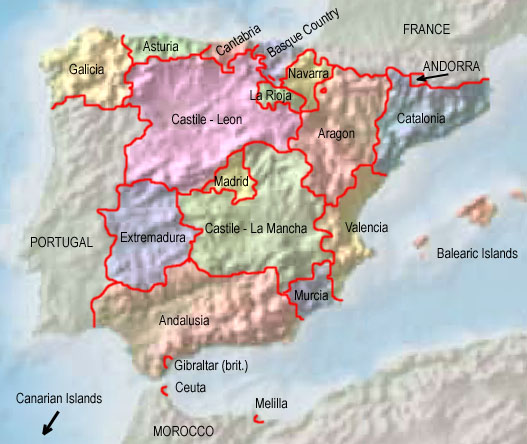 |
| Quelle/Source: Freeware, University of Texas Libraries, modyfied by: Volker Preuß |
|
Karte der historischen Königreiche auf der Iberischen Halbinsel (ca. 1220) – Map of the historical Kingdoms on the Iberian Peninsula (ca. 1220): Interaktive Landkarte - interactive map |
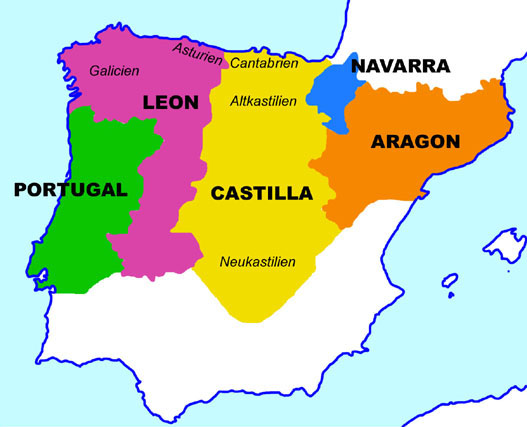 |
| Landkarte/map by: Volker Preuß |
| Zahlen und Fakten – Numbers and Facts: | |
|
|
|
|
|
|
|
|
|
|
|
|
|
|
|
|
|
Frühzeit
· Besiedlung durch Iberer ca. 600 v.Chr. · Einwanderung von Kelten, Vermischung mit den Iberern, Herausbildung der Keltiberer (darunter der Stamm der Galläker) 218–201 v.Chr. · Zweiter Punischer Krieg, das Römische Reich erwirbt die Besitzungen Karthagos in Iberien, Unterwerfung der ganzen Iberischen Halbinsel bis zum Jahre 19 v.Chr., römische Besiedlung, Romanisierung, das heutige Galicien kommt zur römischen Provinz Hispania Tarraconensis ca. 400 · Völkerwanderung, Durchzug germanischer Sweben, Vandalen und Westgoten ca. 410 · Entstehung des Reiches der Sueben im heutigen Portugal und Galicien unter König Hermerich 411 · das Reich der Sueben wird weströmischer Föderat 583–583 · Erb- und Thronfolgekriege 585 · das Reich der Sueben wird von den benachbarten Westgoten erobert 711–714 · Vernichtung des Westgotenreichs durch von Nordafrika kommende Araber, die Westgoten ziehen sich nach Asturien zurück 716 · Ankunft der Araber in Galicien, das Land wird jedoch nicht besetzt, nicht dem Emirat Cordoba angegliedert und nicht arabisch besiedelt 813 · in der Ortschaft Compostela werden die Gebeine des Apostels St. Jakob (spanisch Santiago) gefunden 882 · Fürst Pelayo von Oviedo (Asturien) befreit die Stadt Leon von den Moslems und besetzt ganz Galicien, Errichtung des Königreichs Oviedo 910 · Tod von König Alfons III. von Oviedo, Erbteilung seines Reiches unter seinen Söhnen, sein Sohn Garcia I. wird König von Leon, sein Sohn Ordoño II. wird König von Galizien, sein Sohn Fruela II. erbt Asturien 914 · Tod von König Garcia I., sein Bruder König Ordoño II. von Galizien erbt Leon 914–924 · Herrschaft von König Ordoño II. von Galizien und Oviedo (Asturien) 924 · Tod von König Ordoño II., das Erbe fällt an König Fruela II. von Oviedo (Asturien), er verlegt seine Residenz von Oviedo nach Leon, das Land wird ab jetzt Königreich Leon genannt 931–950 · Herrschaft von König Ramiro II., ein Sohn von Ordoño II., Vereinigung von Galicien, Asturien und Leon unter einer Krone (Königreich Leon), erfolgreiche Kriege gegen die Araber, Ausdehnung des Reiches 1037 · Aussterben der Dynastie Pelayo, das Königreich Leon erbt König Ferdinand von Kastillien, Kastilien und León werden unter einer Krone vereinigt 1060–1071 · Galicien ist kurzzeitig wieder ein eigenes Königtum unter Don García, danach wieder an Kastilien-Leon (bzw. Spanien) 1808–1813 · Galicien ist durch französische Truppen besetzt 1833 · die bis dato in Spanien bestehenden Teilkönigreiche und Regionen werden in Provinzen aufgeteilt, das Königreich Galicien in die Provinzen Lugo, Orense, Pontevedra und La Coruña 1936–1939 · Spanischer Bürgerkrieg, Galicien kämpft an der Seite der Franco-Truppen gegen die sozialistische Zentralregierung 28.04.1981 · Galicien erhält das Autonomiestatut innerhalb Spaniens (unter Zusammenfassung der Provinzen Lugo, Orense, Pontevedra und La Coruña), Gründung der "Autonomen Gemeinschaft Galicien" |
|
early age · settlement by Iberians ca. 600 B.C. · immigration of Celts, mix with the Iberians, evolution of the Celtiberians (among them the tribe of the Gallecians) 218–201 B.C. · Second Punic War, the Roman Empire acquires the possessions of Carthago in Iberia, subjugation of whole Iberia until the year 19 B.C., Roman settlement, romanization, the today’s Galicia comes to the Roman province of Hispania Tarraconensis ca. 400 A.D. · Great Transmigration (Migration Period), immigration of Alans, Suebs and Western Goth ca. 410 · establishment of the Empire of the Suebs in the today’s Portugal and Galicia under King Hermerich 411 · the Empire of the Suebs becomes a West-Roman federate 583–583 · legacy and throne succession wars 585 · the Empire of the Suebs becomes conquered by the neighbouring Western Goth 711–714 · annihilation of the Empire of the Western Goth by from northern Africa coming Arabs, the Western Goth retreat to Asturia 716 · arrival of the Arabs in Galicia, but the country becomes not occupied, not affiliated to the Emirate of Cordoba and not populated by the Arabs 813 · in the town Compostela were found the remains of Apostle St. Jacob (Spanish Santiago) 882 · Prince Pelayo of Oviedo (Asturia) liberates the town Leon from the Muslims and occupies whole Galicia, establishment of the Kingdom of Oviedo 910 · death of King Alfons III. of Oviedo, division of his empire under his sons, his son Garcia I. becomes King of Leon, his son Ordoño II. becomes King of Galicia, his son Fruela II. inherits Asturia 914 · death of King Garcia I., his brother King Ordoño II. of Galicia inherits Leon 914–924 · reign of King Ordoño II. of Galicia and Oviedo (Asturia) 924 · death of King Ordoño II., the heritage comes to King Fruela II. of Oviedo (Asturia), he transfers his residence from Oviedo to Leon, the country is named Kingdom of Leon from that point in time 931–950 · reign of King Ramiro II., a son of Ordoño II., unification of Galicia, Asturia and Leon under one crown (Kingdom of Leon), successful wars against the Arabs, expansion of the empire 1037 · vanish of the Pelayo dynasty, the Kingdom of Leon inherits King Ferdinand of Castile, Castile and Leon become united under one crown 1060–1071 · Galicia is momentary an own kingship again under Don García, after that it comes back to Castile-Leon (resp. Spain) 1808–1813 · Galicia is occupied by French troops 1833 · the until that point in time in Spain existing partial kingdoms and regions become divided in provinces, the Kingdom of Galicia in the provinces of Lugo, Orense, Pontevedra and La Coruña 1936–1939 · Spanish civil war, Galicia fights on the side of the troops of General Franco against the socialistic central government 28th of April 1981 · Galicia gets the statute of autonomy within Spain (by summary of the provinces of Lugo, Orense, Pontevedra and La Coruña), establishment of the "Autonomous Community of Galicia" |
| Quelle/Source: Wikipedia (ES), World Statesmen, Volker Preuß |
| Der Name "Galicien" geht auf den keltiberischen Stamm der Galläker (auch Kallaiker) zurück, der hier siedelte. Die Römer nannten den Stamm "Callaici" und das Land "Gallaecia". Dieser Landesname blieb auch unter der Herrschaft der Sueben und Westgoten erhalten, hat sich jedoch über die Jahre zum heutigen "Galicia" verändert. | The name
"Galicia" has its roots in the Celtiberian tribe of the Gallecians
(Callaicians too) which lived here. The Romans called this tribe "Callaici" and the country "Gallaecia". That name continued as well under the rule of the Suebs and Western Goth and was however changed in the years to the today’s "Galicia". |
| Um Verwechslungen mit der osteuropäischen Region Galizien zu vermeiden wird für das spanische Galizien häufig die Schreibweise Galicien angewandt. | The
Eastern European region of Galicia is easily confused with the
Spanish region of Galicia because of the same spelling in English. |
| Quelle/Source: RetroBib Retrobibliothek, Volker Preuß | |